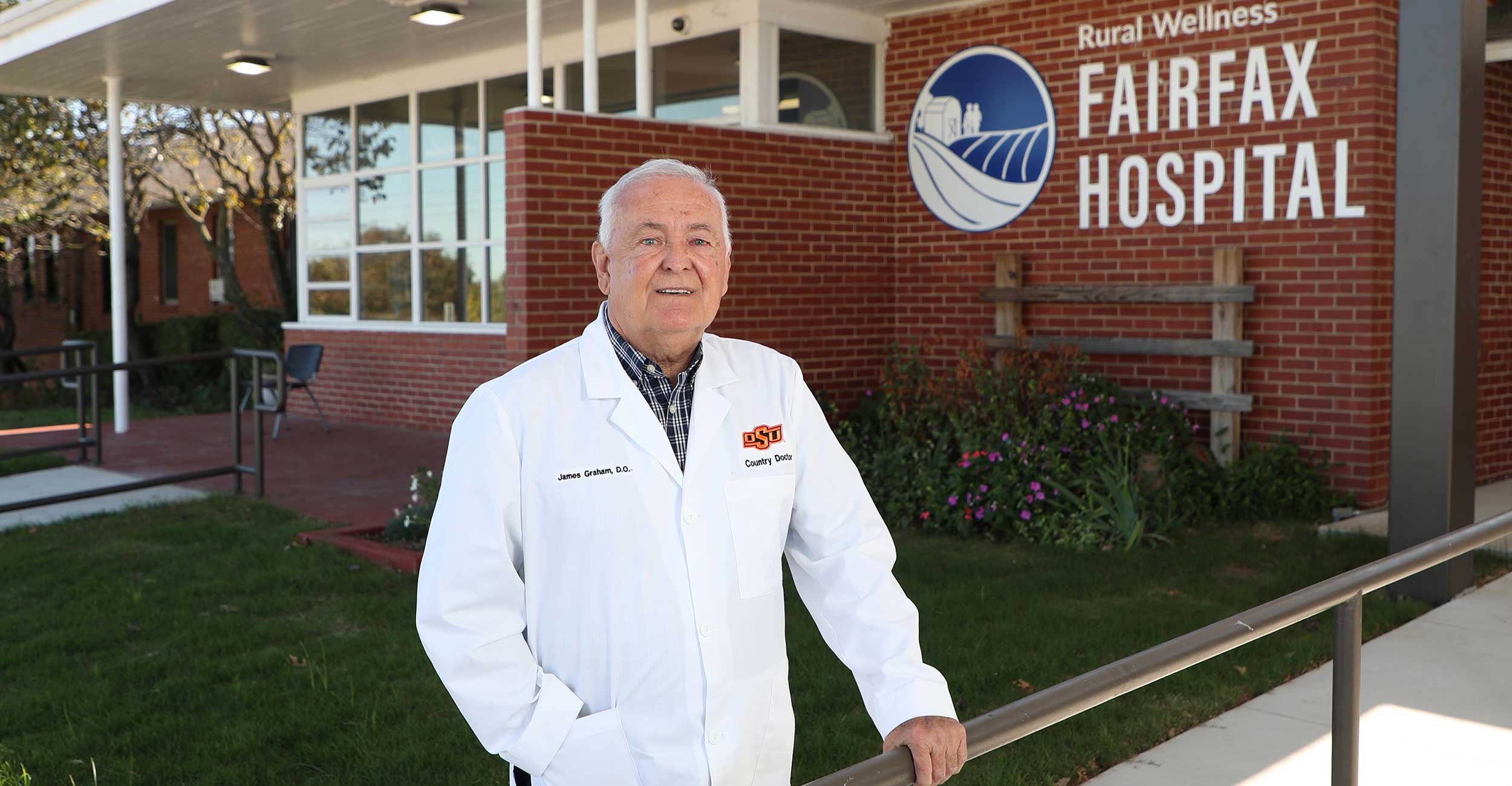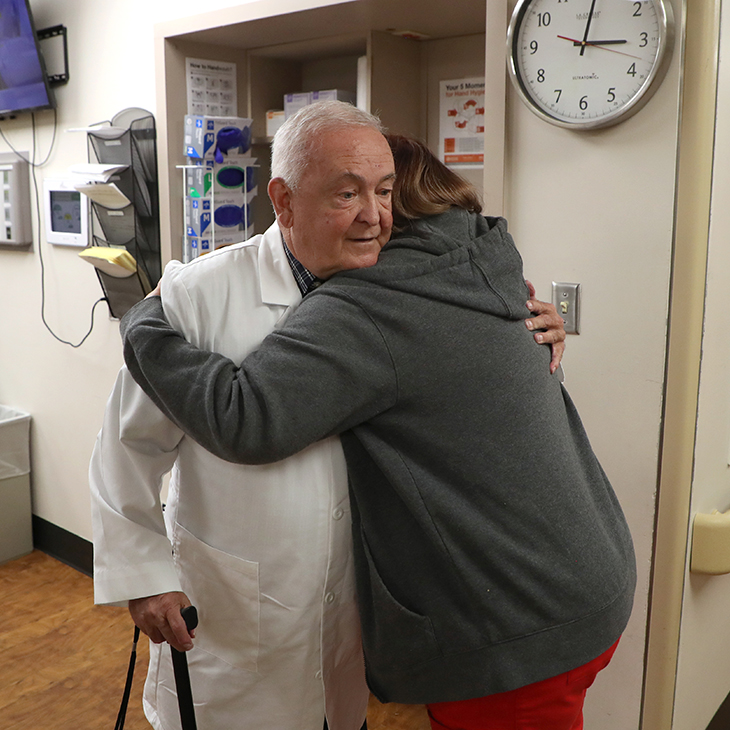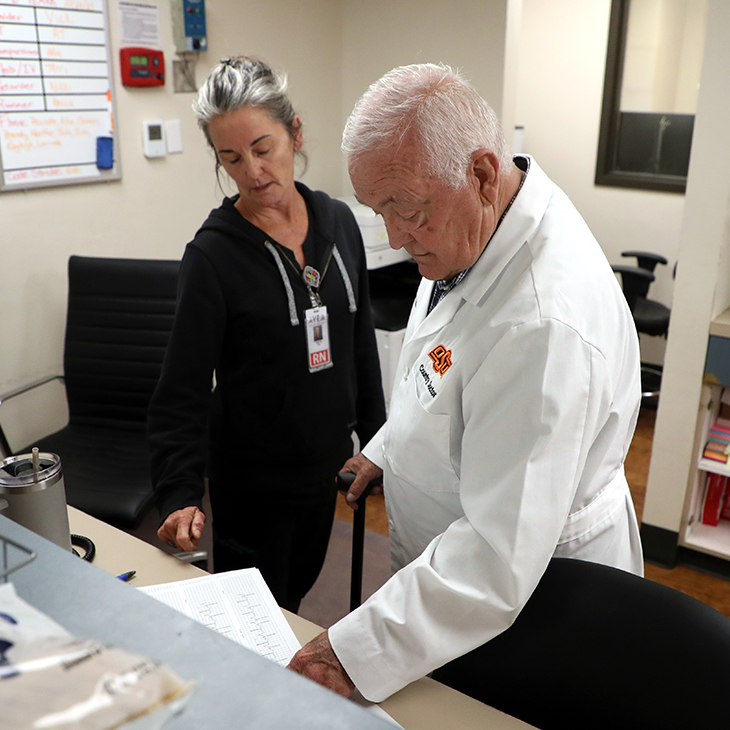
‘I wish I had a country doctor’
Thursday, October 23, 2025
Media Contact: Sara Plummer | Senior Communications Coordinator | 918-561-1282 | sara.plummer@okstate.edu
OSU-COM alumnus James Graham central figure of new documentary ‘Country Doctor’ debuting on HBO
“For me, it’s not just seeing patients, you’re seeing people.”
That’s been Dr. James Graham’s approach to medicine for nearly 50 years as a family medicine physician in the small town of Fairfax, Oklahoma.
“I’m not the world’s best doctor by any stretch, but I am kind. I am kind and I’m compassionate. That goes a long way. Just pay attention and give them your time,” he said.
His dedication to the health and well-being of his patients is why Graham is the centerpiece of the new short-film documentary “Country Doctor” that premiers Oct. 28 on HBO.
The film looks at the crisis of rural health care in the United States through the lens of Graham, his colleagues and his community who fought to keep their small rural hospital open.
“We wanted to tell a story that would show the challenges and issues facing a modern country doctor,” said Shari Cookson, one of the filmmakers and producers of the documentary. “Dr. Graham invited us into his world without conditions. The caring and comfort that Dr. Graham gives to his patients is unlike anything I’ve experienced living in a big city. I wish I had a country doctor.”
Real rural beginnings
Even before he was a physician, Graham knew firsthand the struggles of rural health care. He grew up in the small town of Marland, Oklahoma, and at 16 years old became his mother’s primary caregiver when she went into renal failure.
At the time there were only two dialysis machines in the state, Graham said, so he had to learn how to administer his mother’s dialysis treatments at home.
After completing his bachelor’s degree in 1974, he applied to the Oklahoma College of Osteopathic Medicine and Surgery in Tulsa and graduated in 1978. Ten years later, his alma mater became OSU College of Osteopathic Medicine, a point of pride for Graham.
“I’ve stayed up with the school and what’s going on and the progress that’s been made. I’m very proud of the school and very proud of what the people do there and how they run it,” he said. “What we started out to do was supply rural Oklahoma with physicians and that’s still what we’re trying to do.”
After graduation, Graham moved to Fairfax, where his mother was living, to continue to care for her and the rest of the community, and it's where he's been for 47 years.
“You know, us older doctors come in and commit, that’s the way our generation did it. You get involved with the people, it becomes more than just a job. I guess you can say you’re a big fish in a small pond, but you become a part of it,” he said. “I’ve got patients I’ve been seeing for 45 years, I delivered some of them. Back when we were in medical school, you learned how to do everything. They trained us well. We had to be prepared to do surgery or obstetrics, I did all that.”

Real rural struggles
Graham said the toughest part of his job hasn’t occurred in patient rooms, but in administrative offices.
“The challenge has always been trying to keep the hospital open. There’s never enough money, never enough reimbursement, never enough providers,” he said. “It’s a constant problem and we’re still facing it.”
In 2019, the hospital was operating under an unscrupulous owner with a skeleton crew who went three months without a paycheck just to keep the emergency room doors open. As the longest-serving doctor in the community, Graham was the hospital’s biggest and most vocal champion.
“Fairfax hospital was very close to disappearing forever. But as Dr. Graham says in the film, he and the community didn’t quit in their efforts to save it. And because they fought and sacrificed, Fairfax has a hospital today,” Cookson said. “This was a great source of inspiration for me about values and the power of perseverance.”
Cookson and her filmmaking partner, Nick Doob, visited Fairfax eight times between 2019 and 2022 and then spent another two years putting the film together.
“We spent six years making this film. Dr. Graham inspired us. We met him at 5:30 in the morning to do his rounds as he did most mornings, often traveling to where they lived. He’d known his patients for years, sometimes decades, and cared for them addressing their needs,” Doob said, but his mission is beyond Fairfax. “He was on a crusade to bring decent health care to the millions throughout the country who don’t have it.”
The documentary “Country Doctor” follows not only Graham, but the dedication of the hospital staff and the community in working to save their hospital.
“It isn’t just about me. It’s about the people that didn’t take any salary. We didn’t get paid for three months. It’s about those other 30 people that stood in here and worked when we didn’t have supplies just to keep the door open. They’re the real heroes,” Graham said.
It also follows the aftermath of the hospital’s sale to an unlikely new owner, Dr. Elizabeth Pusey.
“Dr. Pusey was a surprise. She just popped out of the sky. We were expecting the worst, but that didn’t happen,” Doob said.
"The caring and comfort that Dr. Graham gives to his patients is unlike anything I’ve
experienced living in a big city. I wish I had a country doctor.”
Real rural hope
Pusey, a California-based radiologist, is also founder and president of Rural Wellness Inc., which she established to purchase the Fairfax hospital after reading about the community’s struggles and efforts to save its hospital.
Since its purchase, Graham said a number of much-needed improvements have happened in recent years including a new roof, generators, expansion of the patient wing, new radiology medical equipment and salary increases for hospital employees. Work is also underway on a new outpatient clinic in Fairfax.
“She’s done more than just buy a hospital, she’s a bought a city. It caught her heart. She gives a lot of money to the school system, she gives money to the community through her nonprofit organization,” Graham said. “She saved us when we would have been closed. It’s not every day you get miracles like we got.”

And even though things are looking up in Fairfax, Graham said not every community is so lucky.
“We’re in a health care crisis in rural America and somehow somebody needs to help. It jeopardizes lives, it really does,” he said, so he hopes the documentary will help raise awareness of just how vital rural hospitals and clinics are to those living there. “We need to be taking care of the people that need help. I believe everyone deserves health care in America.”
Cookson said “Country Doctor” is a microcosm of the crisis affecting rural health care in the United States.
“We wanted to tell the hospital’s story from the inside, to see the situation through the eyes of the town’s residents — both the hopeful and the skeptical — as well as from the perspective of the new owner,” she said. “We are so excited to share our documentary with the country. Dr. Graham would often tell us the film could make a difference. We hope it will. The need for good, sustainable health care is vitally important for all of us.”
Graham has seen both sides of that need as a physician but also as a patient. He’s undergone two kidney transplants, a triple bypass surgery, a pacemaker implanted and his feet amputated. But he has no plans to retire just yet.
“I will have to one day, but there’s still a lot of people who need help. Health care today — it’s still very inspiring,” he said, recounting how a nurse held his hand and stayed with him as he was wheeled back for his pacemaker surgery just a few months ago. “The kindest, most compassionate people are in this profession. It doesn’t matter if it’s in Fairfax, Oklahoma, or New York City, that’s the case.”
